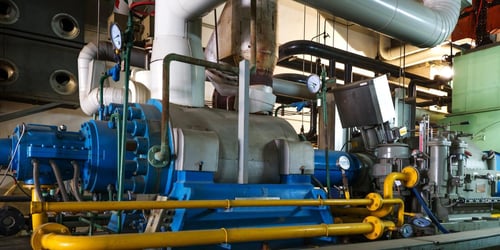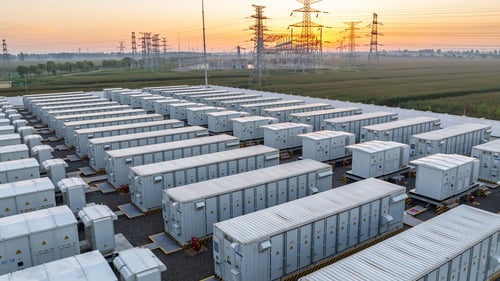Why do we need more demand-side attention for a successful energy transition?
.jpg?width=768&name=Article%20Thumbnails%20-%201920x1080%20new%20website%20(29).jpg)
In the last months, we have been observing the development of new policies and ambitious goals, bringing us closer to a Net Zero economy.
- During COP26 which took place in Glasgow in 2021, 23 countries pleaded to phase out coal power, with 5 of them being in the world's top 20 coal-using countries. Those pledges mean higher integration of renewable energy sources into the energy systems in the upcoming years - a key building block of the energy transition.
- At the same time, key sectors such as transport and heat are undergoing electrification, which results in rising electricity demand.
After Glasgow, a particular conclusion comes to mind - a lot of momentum can be observed on the supply side (continuously rising number of renewables), while not enough thought is given to the demand side. What does that mean?

The integration of renewable energy sources presents a specific set of challenges, their intermediate nature being one of them. To put it simply, we cannot force the sun to shine brighter or the wind to blow stronger to meet the demand for electricity at a given moment. At the same time, the continuously rising demand is not making matters easier. There seems to be a key piece missing between production and consumption. Without bridging this gap, issues such as the imbalance between supply and demand resulting in power outages, grid congestion, and unpredictable energy prices will only continue to occur.
Without taking proper care of smart energy distribution, integration of renewables can result in periods of lower supply and higher demand, especially in winter. When such an occurrence takes place, energy suppliers are forced to buy electricity from emergency reserves, to satisfy their consumer’s needs. A causal relationship between the need to buy more electricity from those emergency reserves when the supply is lacking and a higher end price for electricity, can indeed be observed.
Regulatory support for demand-side flexibility is needed
Enabling demand-side flexibility to participate in all markets is a crucial building block to a successful transition towards a fully renewable energy system. To put it simply, flexibility provides customers with the option to add, lower, change or postpone their production and/or consumption of electricity. The inherent flexibility of the electric assets makes it all possible without negatively impacting the processes' efficiency or quality. One of the most efficient ways to unlock the flexibility of electric assets is to allow independent aggregators to offer Demand Response and energy storage services, to help shape the electricity systems of the future. Aggregators acting as independent players (i.e. not affiliated to energy suppliers) are able to provide services to the different market participants (TSOs, DSOs, suppliers, and utilities) while avoiding conflict of interests. This benefits the energy system as a whole, by maximising the value of flexibility to the benefit of asset owners and enabling competition in markets where flexibility is traded - ultimately reducing costs for all electricity consumers. It will help accelerate the global transition towards ‘net zero’ by developing smarter, cleaner renewable energy systems capable of relieving spikes in European energy supply and demand.
Demand-side flexibility is a key building block for a successful energy transition, however, to unlock its full potential a sound and reliable regulatory framework is needed.
Other articles you might find interesting
-
 Demand-side flexibility7 March 2022
Demand-side flexibility7 March 2022District Heating Operators: New Revenue From Grid Balancing
Read more -
 Demand-side flexibility7 March 2022
Demand-side flexibility7 March 2022Five Myths About Demand Response, Debunked!
Read more -
 Demand-side flexibility7 March 2022
Demand-side flexibility7 March 2022BESS & Demand Response, What’s the Connection?
Read more -
.jpg?length=500&name=Article%20Thumbnails%20-%201920x1080%20new%20website%20(4).jpg) Demand-side flexibility7 March 2022
Demand-side flexibility7 March 20223 Things to Look for in a Flexibility Service Provider
Read more -
.jpg?length=500&name=Article%20Thumbnails%20-%201920x1080%20new%20website%20(35).jpg) Demand-side flexibility7 March 2022
Demand-side flexibility7 March 2022smartEn Executive Director Michael Villa on the future of energy flexibility in Europe
Read more -
.jpg?length=500&name=Article%20Thumbnails%20-%201920x1080%20new%20website%20(34).jpg) demand response7 March 2022
demand response7 March 2022Getting Europe’s Grids Fit for the 21st Century - Interview With SmartEn’s Executive Director Michael Villa
Read more -
 Demand-side flexibility7 March 2022
Demand-side flexibility7 March 2022Empowering Industry through Energy Flexibility - Q&A with Raphaël Gras
Read more -
 demand response7 March 2022
demand response7 March 2022EU elections: Opportunity or Risk for Demand-Side Flexibility? - Q&A with Mathilde Chareyron
Read more -
.jpg?length=500&name=Article%20Thumbnails%20-%201920x1080%20new%20website%20(5).jpg) Knowledge7 March 2022
Knowledge7 March 2022How to Earn Revenue with Demand Response
Read more -
.jpg?length=500&name=Article%20Thumbnails%20-%201920x1080%20new%20website%20(6).jpg) Demand-side flexibility7 March 2022
Demand-side flexibility7 March 2022Five Times Demand Response Saved the Grid
Read more